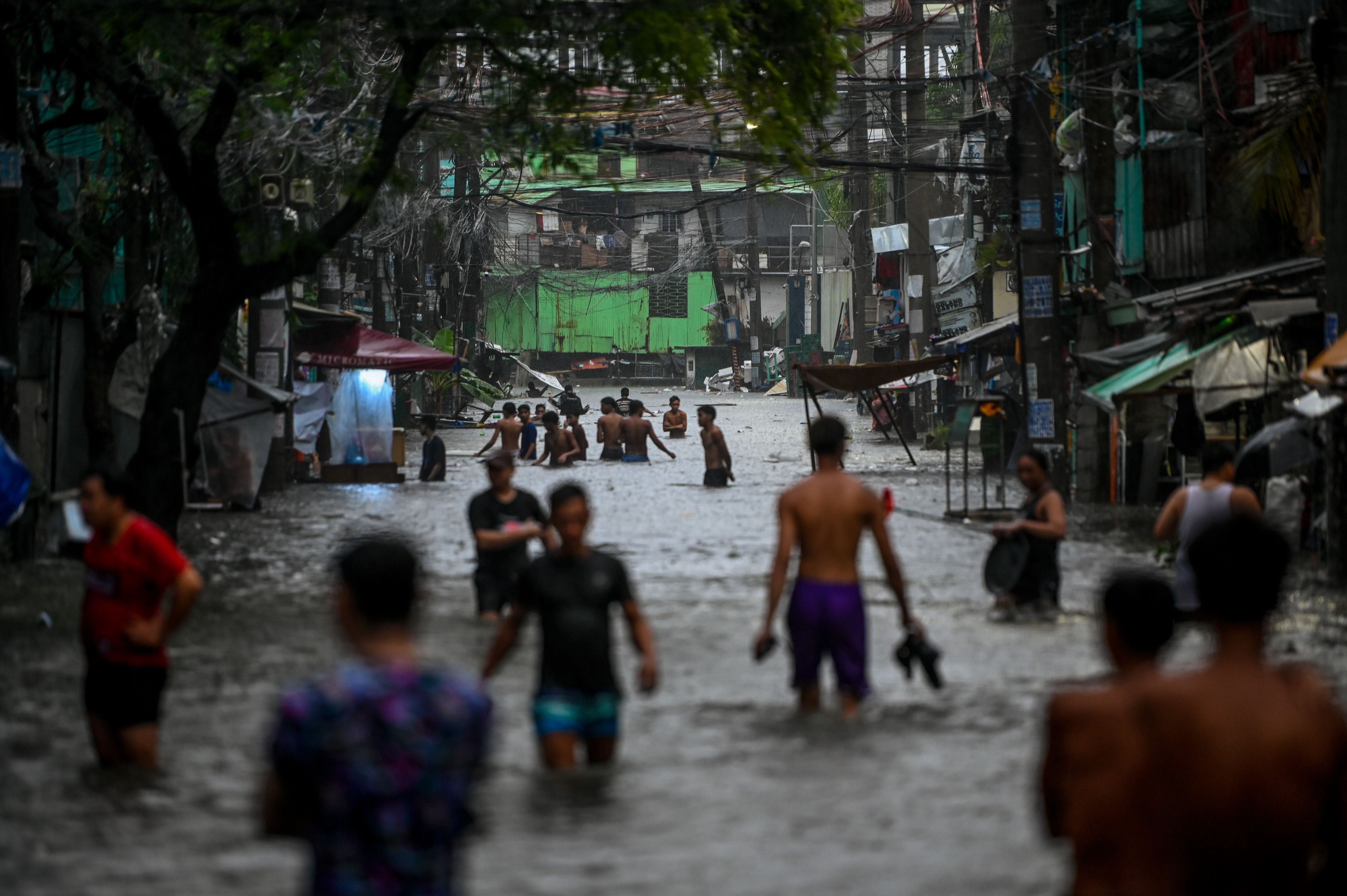Filipinos need more support in disaster preparedness: Harvard study
ADVERTISEMENT

Welcome, Kapamilya! We use cookies to improve your browsing experience. Continuing to use this site means you agree to our use of cookies. Tell me more!
Filipinos need more support in disaster preparedness: Harvard study
Dennis Gasgonia,
ABS-CBN News
Published Nov 07, 2024 11:17 PM PHT
 Residents wade through knee to waist-deep flood in Quezon City on July 24, 2024. Maria Tan, ABS-CBN News/file
Residents wade through knee to waist-deep flood in Quezon City on July 24, 2024. Maria Tan, ABS-CBN News/file
 Residents wade through knee to waist-deep flood in Quezon City on July 24, 2024. Maria Tan, ABS-CBN News/file
Residents wade through knee to waist-deep flood in Quezon City on July 24, 2024. Maria Tan, ABS-CBN News/fileFilipinos are much better prepared against disasters more than a decade since typhoon Yolanda.
Filipinos are much better prepared against disasters more than a decade since typhoon Yolanda.
But a Harvard study on disaster preparedness showed that the country needs significant work to avert the effects of calamities.
But a Harvard study on disaster preparedness showed that the country needs significant work to avert the effects of calamities.
According to the Harvard Humanitarian Initiative,Filipinos’ self-reported disasterpreparedness level has increased by 42% on average over the past seven years.
According to the Harvard Humanitarian Initiative,Filipinos’ self-reported disasterpreparedness level has increased by 42% on average over the past seven years.
“Nationwide data collected from 4,608 Filipinos across all regions from February to March 2024 show an average score of 19.2 out of 50 across five objective measures of disaster preparedness: planning, training, material investment, information, and social support,” the HHI said in an article posted on Harvard’s website.
“Nationwide data collected from 4,608 Filipinos across all regions from February to March 2024 show an average score of 19.2 out of 50 across five objective measures of disaster preparedness: planning, training, material investment, information, and social support,” the HHI said in an article posted on Harvard’s website.
ADVERTISEMENT
It said the number marks a significant jump from an average score of 13.5 out of 50 in a pioneering study conducted by HHI in 2017.
It said the number marks a significant jump from an average score of 13.5 out of 50 in a pioneering study conducted by HHI in 2017.
But the level of preparedness is not enough for the Philippines, which has the highest disaster risk in the world.
But the level of preparedness is not enough for the Philippines, which has the highest disaster risk in the world.
“A score of 19.2 highlights both progress and areas needing urgent attention. While it shows an improvement in disaster preparedness, the score suggests that Filipinos are only doing 38.4% of the kinds of disaster preparedness activities needed to be prepared,” said HHI DirectorVincenzo Bollettino.
“A score of 19.2 highlights both progress and areas needing urgent attention. While it shows an improvement in disaster preparedness, the score suggests that Filipinos are only doing 38.4% of the kinds of disaster preparedness activities needed to be prepared,” said HHI DirectorVincenzo Bollettino.
“For a country as vulnerable to disasters as the Philippines, this is not enough, so we must accelerate our efforts to ensure Filipinos are investing, planning, training, and building closer ties to their communities.”
“For a country as vulnerable to disasters as the Philippines, this is not enough, so we must accelerate our efforts to ensure Filipinos are investing, planning, training, and building closer ties to their communities.”
SOCIAL SUPPORT
The statistics revealed that Filipinos scored highest in information (4.9 out of 10) but scored lowest in social support (2.3 out of 10).
The statistics revealed that Filipinos scored highest in information (4.9 out of 10) but scored lowest in social support (2.3 out of 10).
ADVERTISEMENT
It also cited the participants’ activities related to disaster preparedness.
It also cited the participants’ activities related to disaster preparedness.
The Harvard study showed only a few Filipinos are members of a group or association (23%) and are familiar with their local disaster risk reduction and management officers (16%).
The Harvard study showed only a few Filipinos are members of a group or association (23%) and are familiar with their local disaster risk reduction and management officers (16%).
“Most Filipinos implemented measures to safeguard important documents like birth certificates and property titles (87%). Many Filipinos also monitor typhoon and other disaster warnings (70%) and familiarize themselves with rainfall warning systems (60%), suggesting they routinely experience water-related hazards, such as storms and floods,” said the study.
“Most Filipinos implemented measures to safeguard important documents like birth certificates and property titles (87%). Many Filipinos also monitor typhoon and other disaster warnings (70%) and familiarize themselves with rainfall warning systems (60%), suggesting they routinely experience water-related hazards, such as storms and floods,” said the study.
DISASTER MANAGEMENT PLANS
But Filipinos are lacking on disaster management plans.
But Filipinos are lacking on disaster management plans.
“Only a few have prepared their respective disaster management plan (20%), Go bag (27%), adequate supplies of regularly taken medications (32%), and first-aid kit (33%),” it said.
“Only a few have prepared their respective disaster management plan (20%), Go bag (27%), adequate supplies of regularly taken medications (32%), and first-aid kit (33%),” it said.
ADVERTISEMENT
Dr. Patrick Vinck, Director of Research at HHI, said the enhancement of disaster preparedness needs the help of “local leadership.”
Dr. Patrick Vinck, Director of Research at HHI, said the enhancement of disaster preparedness needs the help of “local leadership.”
“Enhancing the Philippines' disaster preparedness requires investing in local leadership and leveraging technology to improve early warning systems and community engagement, among other critical measures,” he said.
“Enhancing the Philippines' disaster preparedness requires investing in local leadership and leveraging technology to improve early warning systems and community engagement, among other critical measures,” he said.
“This should be accompanied by investments in resilient infrastructures, local capacities, and anticipatory actions.”
“This should be accompanied by investments in resilient infrastructures, local capacities, and anticipatory actions.”
REGIONS WITH HIGHEST LEVEL OF PREPAREDNESS
Among the regions with highest level of preparedness are the Cordillera Administrative Region (24.0 out of 50), Central Visayas (21.5), and Western Visayas (21.4).
Among the regions with highest level of preparedness are the Cordillera Administrative Region (24.0 out of 50), Central Visayas (21.5), and Western Visayas (21.4).
The regions with least preparedness are Davao Region (17.3), Negros Island (15.8), and Bangsamoro Autonomous Region in Muslim Mindanao or BARMM (15.1)
The regions with least preparedness are Davao Region (17.3), Negros Island (15.8), and Bangsamoro Autonomous Region in Muslim Mindanao or BARMM (15.1)
ADVERTISEMENT
The National Capital Region has a score of 19.1, slightly below the national average (19.2). It is also one of the regions with the least progress in disaster preparedness over time, with an increase in preparedness score by only 22% or 3.4 points from 15.7 in 2017.
The National Capital Region has a score of 19.1, slightly below the national average (19.2). It is also one of the regions with the least progress in disaster preparedness over time, with an increase in preparedness score by only 22% or 3.4 points from 15.7 in 2017.
“NCR is the heart of the Philippine economy and home for a significant part of the country’s population, yet it is routinely hit by natural hazards; thus, increasing its disaster preparedness is crucial,” said Bollettino.
“NCR is the heart of the Philippine economy and home for a significant part of the country’s population, yet it is routinely hit by natural hazards; thus, increasing its disaster preparedness is crucial,” said Bollettino.
ADVERTISEMENT
ADVERTISEMENT


